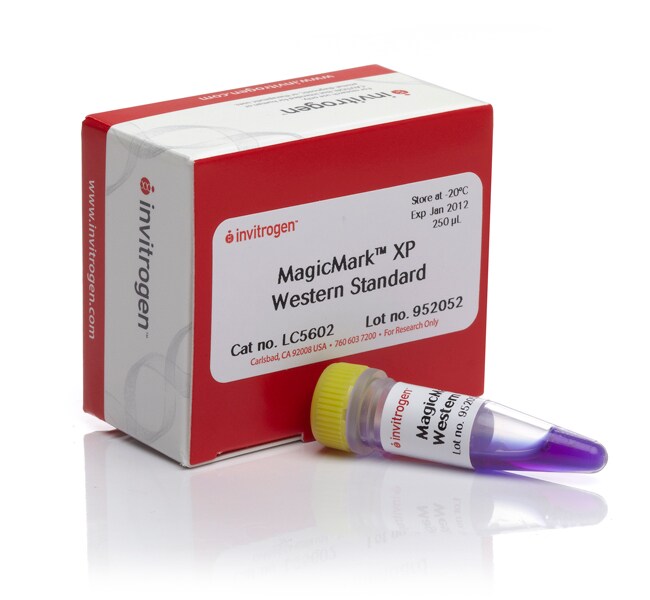Search Thermo Fisher Scientific

Invitrogen™
MagicMark™ XP Western-Proteinstandard
Der MagicMark XP Western Proteinstandard besteht aus 9 rekombinanten Proteinen (20 – 220 kDa), von denen jedes eine IgG-Bindungsstelle besitzt.Weitere Informationen
| Katalognummer | Menge |
|---|---|
| LC5602 | 250 μl |
| LC5602X4 | 4 x 250 μl |
| LC5603 | 50 μl |
Katalognummer LC5602
Preis (EUR)
330,00
Each
-
Menge:
250 μl
Preis (EUR)
330,00
Each
Der MagicMark XP Western Proteinstandard besteht aus 9 rekombinanten Proteinen (20 – 220 kDa), von denen jedes eine IgG-Bindungsstelle besitzt. Die IgG-Bindungsstelle bindet den primären oder sekundären Antikörper für die Detektion des Zielproteins und ermöglicht eine direkte Visualisierung des Standards auf dem Western Blot. Der MagicMark XP Standard ist mit den meisten Western-Kits und -Substraten (chemilumineszent, chromogen und fluoreszierend) kompatibel. Der Proteinstandard wird in einem gebrauchsfertigen Format für den direkten Auftrag auf Gele geliefert. Vor der Verwendung muss kein Probenpuffer erwärmt, reduziert oder hinzugefügt werden.
Alle anderen Proteinstandards und -leitern anzeigen und vergleichen ›
Anwendungen
• Western Blotting: Nachweis von neun ungefärbten Banden mit dem Nachweisverfahren, das für das Zielprotein verwendet wird. Kompatibel mit chemolumineszierenden Substraten und fluoreszierenden Sekundärantikörpern (nicht empfohlen für Antikörper, die mit Fluoren im 500 – 550 nm-Kanal markiert sind).
• Abschätzung der Proteingröße: Proteingrößenbestimmung in SDS-Polyacrylamid-Gelen und auf Western Blots mithilfe der Western Blot-Nachweismethode
Alle anderen Proteinstandards und -leitern anzeigen und vergleichen ›
Anwendungen
• Western Blotting: Nachweis von neun ungefärbten Banden mit dem Nachweisverfahren, das für das Zielprotein verwendet wird. Kompatibel mit chemolumineszierenden Substraten und fluoreszierenden Sekundärantikörpern (nicht empfohlen für Antikörper, die mit Fluoren im 500 – 550 nm-Kanal markiert sind).
• Abschätzung der Proteingröße: Proteingrößenbestimmung in SDS-Polyacrylamid-Gelen und auf Western Blots mithilfe der Western Blot-Nachweismethode
Nur für Forschungszwecke. Darf nicht für diagnostische Verfahren eingesetzt werden.
Specifications
NachweisverfahrenBenutzerdefiniertes Detektionssystem
GelkompatibilitätBolt™ Bis-Tris Plus Gele, Novex™ Tricin-Gele, Novex™ Tris-Glycin-Gele, NuPAGE™ Bis-Tris-Gele, NuPAGE™ Tris-Acetat-Gele, SDS-PAGE-Gele
Molekulargewicht220, 120, 100, 80, 60, 50, 40, 30, 20 kDa
ProduktlinieMagicMark™
ProdukttypProteinleiter
Menge250 μl
Sofort einsatzbereitJa
VersandbedingungTrockeneis
FärbemitteltypUngefärbt
SystemtypWestern Blotting, SDS-PAGE
Number of Markers9
Größenbereich20 bis 220 kDa
Unit SizeEach
Inhalt und Lagerung
250 μl gebrauchsfertiges Standardgemisch, geliefert in einem Kunststofffläschchen. Ladepuffer aus 125 mM Tris-HCl (pH-Wert 6,8), 10 mM DTT, 17,4 % Glycerin, 3 % SDS und 0,025 % Bromophenolblau.
Lagerung bei -20 °C.
Lagerung bei -20 °C.
Limited Time Savings!
Enjoy savings on the remaining stock of iBlot 2 devices, available while supplies last.
